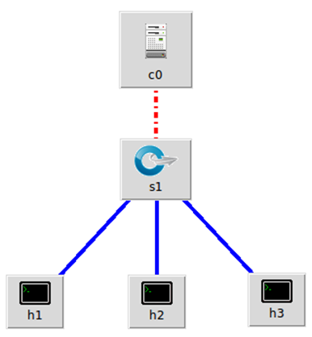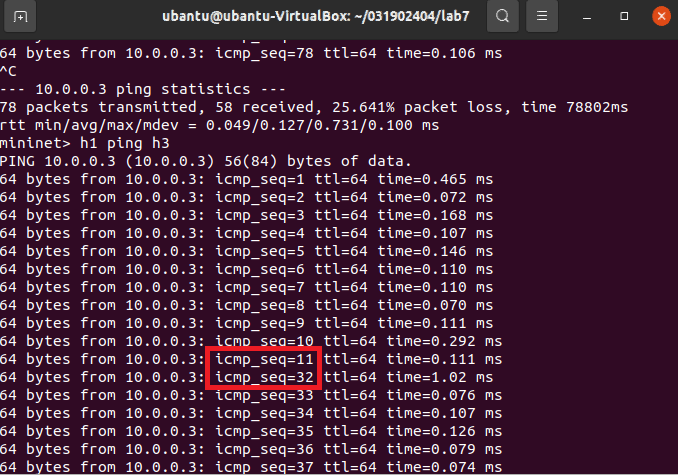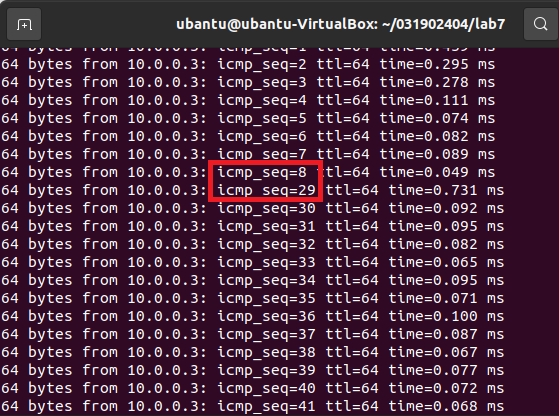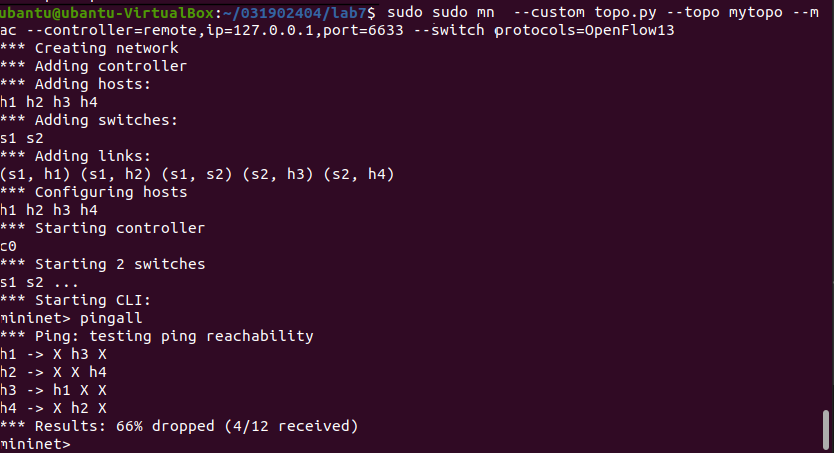实验7:基于REST API的SDN北向应用实践
实验7:基于REST API的SDN北向应用实践
一、实验目的
- 能够编写程序调用OpenDaylight REST API实现特定网络功能;
- 能够编写程序调用Ryu REST API实现特定网络功能。
二、实验环境
- 下载虚拟机软件Oracle VisualBox或VMware;
- 在虚拟机中安装Ubuntu 20.04 Desktop amd64,并完整安装Mininet、OpenDaylight(Carbon版本)、Postman和Ryu;
三、实验要求
(一)基本要求
- OpenDayLight
(1) 利用Mininet平台搭建下图所示网络拓扑,并连接OpenDaylight;
sudo mn --topo=single,3 --mac --controller=remote,ip=127.0.0.1,port=633 --switch ovsk,protocols=OpenFlow13构建拓扑
(2) 编写Python程序,调用OpenDaylight的北向接口下发指令删除s1上的流表数据。
import requests headers = {'Content-Type': 'application/json'} def del_flowtable(url): resp = requests.delete(url, headers=headers) return resp if __name__ == "__main__": url = "http://127.0.0.1:8181/restconf/config/opendaylight-inventory:nodes/node/openflow:1/" resp = del_flowtable(url) print(resp.content)
(3) 编写Python程序,调用OpenDaylight的北向接口下发硬超时流表,实现拓扑内主机h1和h3网络中断20s。
import requests from requests.auth import HTTPBasicAuth headers = {'Content-Type': 'application/json'} def dump_flowtable(url, jstr): resp = requests.put(url, jstr, headers=headers, auth=HTTPBasicAuth('admin', 'admin')) return resp if __name__ == "__main__": url = "http://127.0.0.1:8181/restconf/config/opendaylight-inventory:nodes/node/openflow:1/flow-node-inventory:table/0/flow/1" with open("./flowtable1.json") as f: jstr = f.read() resp = dump_flowtable(url, jstr) print(resp.content)
- flowtable1.json
{ "flow": [ { "id": "1", "match": { "in-port": "1", "ethernet-match": { "ethernet-type": { "type": "0x0800" } }, "ipv4-destination": "10.0.0.3/32" }, "instructions": { "instruction": [ { "order": "0", "apply-actions": { "action": [ { "order": "0", "drop-action": {} } ] } } ] }, "flow-name": "flow1", "priority": "65535", "hard-timeout": "20", "cookie": "2", "table_id": "0" } ] }
- 执行结果

(4) 编写Python程序,调用OpenDaylight的北向接口获取s1上活动的流表数。
import requests from requests.auth import HTTPBasicAuth headers = {'Content-Type': 'application/json'} def get_flowtable(url): resp = requests.get(url, headers=headers, auth=HTTPBasicAuth('admin', 'admin')) return resp if __name__ == "__main__": url = "http://127.0.0.1:8181/restconf/operational/opendaylight-inventory:nodes/node/openflow:1/" \ "flow-node-inventory:table/0/opendaylight-flow-table-statistics:flow-table-statistics" resp = get_flowtable(url) print(resp.content)
- 执行结果

- Ryu
- 开启Ryu控制器
ryu-manager ryu.app.simple_switch_13 ryu.app.ofctl_rest
(1) 编写Python程序,调用Ryu的北向接口,实现上述OpenDaylight实验拓扑上相同的硬超时流表下发。
import requests headers = {'Content-Type': 'application/json'} def dump_flowtable(url, jstr): resp = requests.put(url, jstr, headers=headers) return resp if __name__ == "__main__": url = "http://127.0.0.1:8080/stats/flowentry/add" with open("./flowtable2.json") as f: jstr = f.read() resp = dump_flowtable(url, jstr) print(resp.content)
- 其中, flowtable2.json
{ "dpid": 1, "cookie": 1, "cookie_mask": 1, "table_id": 0, "hard_timeout": 20, "priority": 65535, "flags": 1, "match":{ "in_port":1 }, "actions":[ ] }
- 执行结果

(2) 利用Mininet平台搭建下图所示网络拓扑,要求支持OpenFlow 1.3协议,主机名、交换机名以及端口对应正确。拓扑生成后需连接Ryu,且Ryu应能够提供REST API服务。
- 其中, 拓扑代码
from mininet.topo import Topo class MyTopo(Topo): def __init__(self): # initilaize topology Topo.__init__(self) self.addSwitch("s1") self.addSwitch("s2") self.addHost("h1") self.addHost("h2") self.addHost("h3") self.addHost("h4") self.addLink("s1", "h1") self.addLink("s1", "h2") self.addLink("s2", "h3") self.addLink("s2", "h4") self.addLink("s1", "s2") topos = {'mytopo': (lambda: MyTopo())}
- 构建拓扑
sudo sudo mn --custom mytopo.py --topo mytopo --mac --controller=remote,ip=127.0.0.1,port=6633 --switch ovsk,protocols=OpenFlow13
(3) 整理一个Shell脚本,参考Ryu REST API的文档,利用curl命令,实现和实验2相同的VLAN。
| VLAN_ID | Hosts |
|---|---|
| 0 | h1 h3 |
| 1 | h2 h4 |
- Shell脚本
# 将主机1,2发送来的包打上vlan标记 curl -X POST -d '{ "dpid": 1, "priority": 1, "match":{ "in_port": 1 }, "actions":[ { "type": "PUSH_VLAN", # Push a new VLAN tag if a input frame is non-VLAN-tagged "ethertype": 33024 # Ethertype 0x8100(=33024): IEEE 802.1Q VLAN-tagged frame }, { "type": "SET_FIELD", "field": "vlan_vid", # Set VLAN ID "value": 4096 # Describe sum of vlan_id(e.g. 6) | OFPVID_PRESENT(0x1000=4096) }, { "type": "OUTPUT", "port": 3 } ] }' http://localhost:8080/stats/flowentry/add curl -X POST -d '{ "dpid": 1, "priority": 1, "match":{ "in_port": 2 }, "actions":[ { "type": "PUSH_VLAN", # Push a new VLAN tag if a input frame is non-VLAN-tagged "ethertype": 33024 # Ethertype 0x8100(=33024): IEEE 802.1Q VLAN-tagged frame }, { "type": "SET_FIELD", "field": "vlan_vid", # Set VLAN ID "value": 4097 # Describe sum of vlan_id(e.g. 6) | OFPVID_PRESENT(0x1000=4096) }, { "type": "OUTPUT", "port": 3 } ] }' http://localhost:8080/stats/flowentry/add # 将主机3,4发送来的包取出vlan标记 curl -X POST -d '{ "dpid": 1, "priority": 1, "match":{ "vlan_vid": 0 }, "actions":[ { "type": "POP_VLAN", # Push a new VLAN tag if a input frame is non-VLAN-tagged "ethertype": 33024 # Ethertype 0x8100(=33024): IEEE 802.1Q VLAN-tagged frame }, { "type": "OUTPUT", "port": 1 } ] }' http://localhost:8080/stats/flowentry/add curl -X POST -d '{ "dpid": 1, "priority": 1, "match":{ "vlan_vid": 1 }, "actions":[ { "type": "POP_VLAN", # Push a new VLAN tag if a input frame is non-VLAN-tagged "ethertype": 33024 # Ethertype 0x8100(=33024): IEEE 802.1Q VLAN-tagged frame }, { "type": "OUTPUT", "port": 2 } ] }' http://localhost:8080/stats/flowentry/add # 将主机3,4发送来的包打上vlan标记 curl -X POST -d '{ "dpid": 2, "priority": 1, "match":{ "in_port": 1 }, "actions":[ { "type": "PUSH_VLAN", # Push a new VLAN tag if a input frame is non-VLAN-tagged "ethertype": 33024 # Ethertype 0x8100(=33024): IEEE 802.1Q VLAN-tagged frame }, { "type": "SET_FIELD", "field": "vlan_vid", # Set VLAN ID "value": 4096 # Describe sum of vlan_id(e.g. 6) | OFPVID_PRESENT(0x1000=4096) }, { "type": "OUTPUT", "port": 3 } ] }' http://localhost:8080/stats/flowentry/add curl -X POST -d '{ "dpid": 2, "priority": 1, "match":{ "in_port": 2 }, "actions":[ { "type": "PUSH_VLAN", # Push a new VLAN tag if a input frame is non-VLAN-tagged "ethertype": 33024 # Ethertype 0x8100(=33024): IEEE 802.1Q VLAN-tagged frame }, { "type": "SET_FIELD", "field": "vlan_vid", # Set VLAN ID "value": 4097 # Describe sum of vlan_id(e.g. 6) | OFPVID_PRESENT(0x1000=4096) }, { "type": "OUTPUT", "port": 3 } ] }' http://localhost:8080/stats/flowentry/add curl -X POST -d '{ "dpid": 2, "priority": 1, "match":{ "vlan_vid": 0 }, "actions":[ { "type": "POP_VLAN", # Push a new VLAN tag if a input frame is non-VLAN-tagged "ethertype": 33024 # Ethertype 0x8100(=33024): IEEE 802.1Q VLAN-tagged frame }, { "type": "OUTPUT", "port": 1 } ] }' http://localhost:8080/stats/flowentry/add curl -X POST -d '{ "dpid": 2, "priority": 1, "match":{ "vlan_vid": 1 }, "actions":[ { "type": "POP_VLAN", # Push a new VLAN tag if a input frame is non-VLAN-tagged "ethertype": 33024 # Ethertype 0x8100(=33024): IEEE 802.1Q VLAN-tagged frame }, { "type": "OUTPUT", "port": 2 } ] }' http://localhost:8080/stats/flowentry/addz
执行后如下
四、个人总结
-
实验难度:难
由于对代码理解比较浅显,所以较为困难
-
实验过程遇到的困难:
1.问题:ping主机时发现ping不通
解决方案:python文件又一次抽风,重新装好后解决了
2.问题:Ryu权限出现问题
解决方案:不知道原因,依然是重装,感受到了乌班图有时很不稳定
-
个人感想:
通过这次实验,进一步了解了OpenDaylight和Ryu的使用,阅读官方文档更加熟悉,复习了实验开始时的知识。自己动手比看原理更能加深理解。
-


